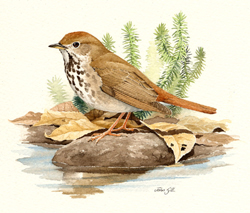Breeding Bird Atlases (BBA)
Find a Bird - BBA1
Breeding Bird Atlas 1 Species Accounts
Hermit Thrush
Catharus guttatus
Egg Dates
May 3 to August 9
Number of Broods
two

Considered by many to be the finest songster in North America, the Hermit Thrush has a wide, though sporadic, breeding distribution across the state. Viewed as rare at the turn of the century, the species has since expanded its breeding range and become common in many locales. During the Atlas period, it was common in the hills of western Massachusetts, scarce to absent in central and northeastern sections, and fairly common but local in portions of the southeastern coastal plain. Nesting was “confirmed” on Martha’s Vineyard.
Migrating Hermit Thrushes first appear in Massachusetts during the last half of April, during which time many will continue farther north. By early May, breeding birds can be heard singing in a variety of secluded woodland habitats, from the damp mixed forests of the western hills to the dry pine barrens along the coastal plain. The common characteristics of these nesting areas are a dense understory of young vegetation and an abundance of evergreens, although woodlands with a good mix of deciduous trees will sometimes suffice.
The song, given primarily at dawn and dusk, is a lovely, ethereal series of flutelike phrases, ascending and descending randomly. The early naturalists were so impressed by the musical refrains of the Hermit Thrush that they called it the “American Nightingale.” The male’s song period may extend from April to late August. A distinctive, soft, low chuck note is given throughout the year and is often the first indication of this reclusive species’ presence. Another common note of both sexes is a tway sound.
The nest is a deep cup of dried grasses, bark fiber, and small twigs, often lined with evergreen needles, and is usually on the ground, although some are built in a small tree up to about 8 feet above the ground. Four recent Massachusetts nests were located as follows: 2 on the ground concealed by low vegetation in mixed forest, 1 on the ground beneath a Mountain Laurel, and 1 on the ground in a fairly open cutover mixed forest under a clump of small White Pine seedlings (CNR, Blodget, Meservey). The normal clutch is three to four eggs, but as many as six have been recorded. Clutch sizes for 9 state nests were as follows: three eggs (4 nests), four eggs (5 nests) (Nice 1933, DKW, CNR, Meservey). The breeding season is protracted, and eggs have been found in nests in our area from May 3 to August 9. Many pairs rear two broods, and the birds will usually renest if an attempt fails; and, although three broods have been suggested, this has not been well documented for Massachusetts.
Incubation, by the female, lasts about 12 days, and the young fledge in another 12 days. Nestlings have been recorded in Massachusetts from mid-May to August 3 and fledglings from early June to August 30 (Nice 1933, BOEM, TC, CNR, Blodget, Meservey). Hatching at a Charlton nest occurred on June 10 (Meservey), at a Lenox nest about July 25 (CNR), and at a Pelham nest on August 3 (Nice 1933). Both sexes care for the young, bringing them a variety of insects, worms, and other small invertebrates.
The southbound migration occurs in October and early November and takes most birds to the southern United States. As in the spring, the Hermit Thrush is a common transient again at this time. However, every year some linger into the winter, especially along the southeastern coast of Massachusetts. Their winter diet consists primarily of berries and fruits, and single birds are found, sometimes in the company of robins, feeding on American Holly, Red Cedar, and Multiflora Rose. Hermits become considerably less retiring in this season and will occasionally make brief appearances at suet feeders, particularly after snowstorms. They are quite hardy and often survive all but the most severe winters.
Map Legend and Data Summary
Atlas 1 data collected from 1975-1979


Note: fairly common in mixed woodlands and pine barrens of the southeastern region
Blair Nikula



